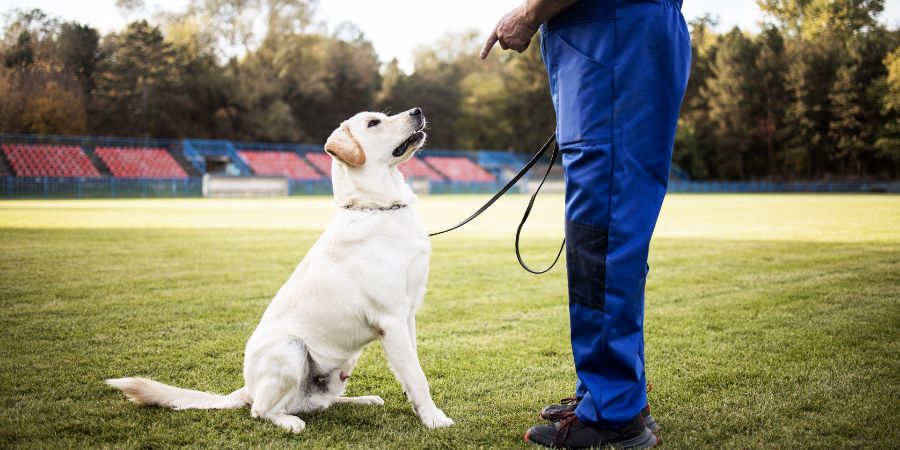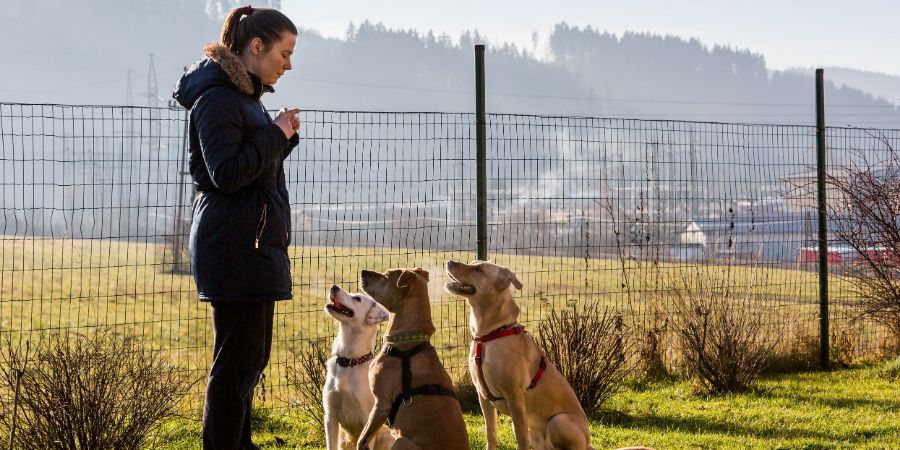There are a lot of myths and misconceptions about dog training. After all, people often believe things that aren’t true, without doing any research. In this article, we’re going to debunk 25 of the most common myths about dog training.
We’ll show you why these myths are wrong, and give you the REAL facts behind proper dog training. Plus, we’ll delve into 5 myths about being a professional dog trainer – and reveal 5 myths about dog training which are actually true!
So, read on to learn more about canine behavior and how to properly train your dog – and, if you’re interested in a career in this field, other people’s dogs, too!
Pro Tip: Learn how to become a professional dog trainer (even if you don’t have any experience) with this Ultimate Guide!
25 Common Dog Training Myths and Why They’re False
Myth #1: You can’t teach an old dog new tricks.
This is one of the most common dog training myths out there – and we can understand why. When a dog is still in its puppy stage, they’re more likely to be open to learning new things and forming new habits.
But because of this, many have come to believe that once a dog ages past a certain point, they’re no longer able to learn new things or be trained.
And this simply isn’t true! Dogs of ANY age can learn new tricks, behaviors, and commands. It may take a little longer to train an older dog, but it’s certainly not impossible.
Myth #2: Your dog is too young to be trained.
In contrast to Myth #1, some people believe that puppies are too young to be trained. After all, they’re just babies – why would you want to start training them so early?
The truth is, the earlier you start training your puppy, the better. In fact, it’s been proven that puppies can begin their training at as early as eight weeks old!
The key is to start small and make the training sessions short. You don’t want to overwhelm your puppy. After all, puppies have short attention spans. But if you combine short training sessions with positive reinforcement (which is how they learn best), you’ll be amazed at how quickly you see the desired results!
Puppies that are properly trained are less likely to develop bad habits or behavioral problems later on in life. So, if you have a new puppy, don’t wait to start their training – the sooner, the better!
Pro Tip: Learn more about when to start training a puppy – and how to do it properly!

Myth #3: Aggressive dogs can’t be trained.
If your dog is exhibiting aggressive behavior, you may be wondering if there’s any hope for them. After all, it seems like they’re hardwired to be aggressive – how can you change that?
The truth is, ANY dog – no matter how aggressive – can be trained. It may take some time and patience, but even the most aggressive dogs can learn to control their behavior.
Of course, it’s important to consult with a professional dog trainer or behaviorist if your dog is exhibiting aggressive behavior. They can help you develop a training plan that’s specifically tailored to your dog’s needs.
But don’t give up hope – even the most aggressive dogs can be trained!
Myth #4: You need to use punishment to train your dog.
One of the most common methods of training dogs is using punishment – and it’s also one of the most controversial. It’s important to know that here, “punishment” means to physically or verbally abuse the dog when they misbehave, aren’t listening, or don’t follow commands. Some people believe that in order to get a dog to obey, you need to punish them when they don’t listen.
But this is NOT true! Dogs should never be physically or verbally abused – this will only make their behavior worse. In fact, studies have shown that dogs who are trained with punishment are more likely to exhibit aggressive behavior.
So, if you’re looking for a way to train your dog that’s both effective AND humane, do not resort to punishment. Rather, positive reinforcement is the way to go.
Pro Tip: Discover what positive reinforcement in dog training is – and why it’s widely considered to be the BEST training method!
Myth #5: You need to be the “alpha” in order to train your dog.
You may have heard that in order to train your dog, you need to be the “alpha.” This means that you need to establish yourself as the leader of the pack – and that you need to do so through force.
But this couldn’t be further from the truth! In fact, dogs are not looking for a leader who will dominate them. Rather, they’re looking for a leader who is calm, confident, and consistent.
So, if you want to train your dog effectively, there’s no need to try to establish yourself as the “alpha.” Just be yourself – and be the best leader you can be!
Myth #6: Dogs can only be trained using treats.
You may have heard that in order to train your dog, you need to be the “alpha.” This means that you need to establish yourself as the leader of the pack – and that you need to do so through force.
But this couldn’t be further from the truth! In fact, dogs are not looking for a leader who will dominate them. Rather, they’re looking for a leader who is calm, confident, and consistent.
So, if you want to train your dog effectively, there’s no need to try to establish yourself as the “alpha.” Just be yourself – and be the best leader you can be!
Myth #7: Dogs can only be trained using positive reinforcement.
Positive reinforcement is one of the most popular methods of training dogs – and for good reason! It’s an effective way to train your dog, and it’s also humane.
And, yes, while dogs can absolutely be trained using only positive reinforcement, it’s not the only method out there. In fact, there are a variety of different training methods – and each has its own advantages and disadvantages.
Some examples of other dog training methods include:
- Operant Conditioning: This method involves using rewards and aversive methods to train your dog. E.g. Say you’re trying to teach your dog to sit. If they don’t do as you ask, the aversive method may be to gentle push the dog’s butt onto the floor while you speak the command. Then you reward the desired behavior with a treat. Eventually, your dog will associate getting a treat with placing their butt on the ground when you say, “Sit”. Thus, they’re more likely to do as you ask.
- Pavlovian Conditioning: This method is based on the work of famed scientist Ivan Pavlov. It involves training your dog to associate a certain stimulus with a desired behavior. E.g. You may ring a bell every time you feed your dog. After a while, your dog will associate the sound of the bell with getting food – and they’ll start to drool when they hear it.
- Classical Conditioning: This method involves linking a desired behavior with a positive reinforcement. E.g. You may give your dog a treat every time they lie down on command. Eventually, your dog will associate lying down with getting a treat – and they’ll be more likely to do it when you ask.

Myth #8: You can housebreak a dog by rubbing their nose in the mess.
If you’ve ever had a dog that’s made a mess in the house, you may be tempted to “rub their nose in it.” But this is actually one of the worst things you can do!
Firstly, it’s ineffective. Dogs don’t understand that this is a punishment for making a mess – all they know is that you’re angry. Secondly, it’s also cruel. Dogs are not trying to be spiteful when they make a mess – they simply don’t know any better.
So, if you find yourself with a dog that’s having accidents in the house, the best thing you can do is be patient and use positive reinforcement to train them. With time and patience, you’ll be able to housebreak your dog – without being mean to them.
Myth #9: Positive dog training doesn’t believe in discipline.
Just because positive dog trainers don’t believe in using negative reinforcement methods such as punishment, doesn’t mean they don’t believe in discipline. In fact, most positive dog trainers believe that discipline is an important part of training – it’s just that they believe there are more effective and humane ways to do it.
For example, rather than rubbing a dog’s nose in their mess, a positive dog trainer may use a method called “time-out.” This involves removing the dog from the situation (e.g. taking them outside) and ignoring them for a short period of time.
The idea is that the dog will learn that they’re being removed from the situation because they’re misbehaving – and they’ll be less likely to do it again in the future.
Myth #10: Crate training is cruel and inhumane.
Crate training is a method of dog training that involves confining your dog to a small space (e.g. a crate or kennel) for short periods of time.
Some people believe that this is cruel and inhumane. And we will definitely agree that when executed poorly, it absolutely is. For example, if you confine your dog to a crate for hours on end with no opportunity to exercise or relieve themselves, then yes, this is cruel.
But, if done correctly, crate training can actually be beneficial for both you and your dog. For instance, it can provide your dog with a safe space to retreat to when they’re feeling overwhelmed. It can also prevent them from getting into mischief when you can’t supervise them.
Ultimately, it’s up to you to decide whether or not crate training is right for your dog. If you do decide to go ahead with it, just be sure to do your research and make sure you’re doing it correctly.
Myth #11: Certain breeds don’t need training.
This is a myth that’s perpetuated by people who own “easy to train” breeds such as Labradors and Golden Retrievers. Similarly, some dog owners believe that they don’t need to train their small breeds, such as Chihuahuas and Yorkshire Terriers.
The truth is, all dogs need training – regardless of their breed. Of course, some breeds may be easier to train than others. But, even the easiest to train breeds will still need some basic obedience training.
So, if you’re thinking of skipping out on training because you believe your dog’s breed doesn’t need it, think again! All dogs can benefit from a good training regime.
Myth #12: Positive dog training methods won’t work on extremely aggressive dogs.
Some people believe that positive dog training methods are only effective on relatively well-behaved dogs. They think that if a dog is aggressive, then these methods won’t work. As a result, the misconception is that super aggressive dogs (a.k.a. “red zone dogs”) can only be trained using negative reinforcement, such as physical and/or verbal punishment.
But, the truth is, positive dog training methods can be effective on even the most aggressive of dogs. It’s just that it may take a bit longer to see results.
The reason for this is that aggressive dogs tend to be more resistant to change. So, it may take a bit longer to train them using positive methods. But, with patience and consistency, you can definitely train an aggressive dog using positive reinforcement.
Furthermore, the reason you should NOT use negative reinforcement training with red zone dogs is because it can make their aggression worse. So, if you’re working with an aggressive dog, be sure to use only positive training methods.

Myth #13: Dogs who aren’t food motivated can’t be trained.
This ties back into Myth #6. Just because your dog isn’t food motivated doesn’t mean they can’t be trained.
There are plenty of dogs out there who couldn’t care less about food rewards. But, that doesn’t mean they can’t learn. These types of dogs may be more motivated by praise, petting, or play.
So, if your dog isn’t food motivated, don’t worry! There are plenty of other ways to motivate them. Just experiment and find what works best for YOUR pup!
Myth #14: Dogs hate getting trained.
This is definitely not true!
Dogs love learning new things. It’s part of their nature. In the wild, they learn survival skills from their elders. And, in our homes, they learn manners and obedience from us.
Of course, there are certain breeds who are more eager to learn, such as:
- Border Collies
- Poodles
- Golden Retrievers
- German Shepherds
- Labrador Retrievers
- Papillons
- Pembroke Welsh Corgis
- Australian Cattle Dogs
Alternately, some dog breeds are admittedly a bit more stubborn (or difficult) when it comes to training:
- Siberian Huskies
- Bullmastiffs
- Chinese Shar-Peis
- Afghan Hounds
- Basset Hounds
- Beagles
- Bulldogs
- Chow Chows
Even still, though, let’s reiterate again: ALL dogs can be trained. It just may take a bit more patience (and treats!) with some breeds than others.
Myth #15: If a dog does something wrong, it’ll look “guilty”.
Have you ever scolded your dog for doing something wrong – only to have them give you “the look”? You know… the big, brown, puppy dog eyes that seem to say “I’m so sorry! I won’t do it again!”
Well, guess what? That guilty look has nothing to do with guilt.
Dogs do not have the ability to feel guilt like we do. So, when they give you that look, it’s not because they’re actually feeling guilty.
Instead, that look is usually a sign of anxiety or fear. Your dog may be anxious because they think you’re going to scold them (even if you don’t). Or, they may be afraid because they think you’re angry with them.
So, the next time your dog gives you “the look”, don’t scold them! Just try to reassure them that everything is okay.
Myth #16: Dogs can hold a grudge.
Nope! Dogs do not have the ability to hold a grudge.
If your dog is acting out or seems angry with you, it’s not because they’re holding a grudge. There’s usually some other reason behind their behavior.
For example, your dog may be acting out because they’re bored, anxious, or stressed. Or, they may be trying to tell you that they need something, like food, water, or a bathroom break.
So, if your dog is acting out, don’t assume that they’re holding a grudge. Instead, try to figure out what the real issue is.
Myth #17: Playing tug of war will make your dog more prone to aggression and/or biting.
This is a common myth, but it’s definitely not true!
Tug of war is actually a great way to build trust and bond with your dog. It’s also a great way to teach them obedience commands, such as “drop it” or “leave it”. Not to mention, there are health benefits, too – such as improving their grip strength and chewing muscles.
Of course, there are certain rules you need to follow when playing tug of war with your dog. For example, you should always make sure that your dog knows that you’re the one in charge. You should also avoid playing tug of war with puppies or small breeds, as they can easily injure themselves.
Other than that, though, tug of war is a great game to play with your dog! Just be sure to follow the rules and use common sense.

Myth #18: You need to regularly ignore your dog in order to prevent separation anxiety.
Once again, this myth is 100% not true.
In fact, ignoring your dog can actually make separation anxiety worse!
If you regularly ignore your dog or leave them alone for long periods of time, they may start to feel anxious or stressed. This can lead to separation anxiety – which is the exact opposite of what you’re trying to achieve.
So, if you want to prevent separation anxiety, the best thing you can do is make sure that your dog always has a positive association with being away from you. This means regularly leaving them alone for short periods of time (30 minutes or less) and making sure that they have plenty of toys, food, and water.
Myth #19: Your dog won’t respect you if you let them sleep in bed with you.
This is another myth that’s based on the false belief that dogs are trying to dominate us.
In reality, though, letting your dog sleep in bed with you has nothing to do with dominance. In fact, it’s actually a sign of trust and companionship.
So, if you want your dog to respect you, there’s no need to ban them from the bed. Just make sure that you’re consistent with your rules and boundaries, and they’ll learn to respect you just fine.
Myth #20: Dog training only refers to obedience.
Dog training is often thought of as only teaching obedience commands, like sit, stay, and come. But, dog training actually encompasses a lot more than that!
Dog training can also include activities like agility, puzzle solving, and even simple tricks. In other words, dog training is anything that helps your dog learn how to behave in the way that you want them to.
So, if you’re looking for ways to help your dog behave better, don’t limit yourself to obedience training. Take a look into any of these other types of dog training:
Agility training
This type of training helps your dog learn how to navigate an obstacle course. It’s a great way to burn off excess energy and have fun at the same time!
Puzzle Solving
This type of training helps your dog learn how to solve simple puzzles. It’s a great way to keep their minds active and engaged. Trick training: This type of training helps your dog learn simple tricks, like shake or roll over. It’s a great way to bond with your dog and have some fun in the process!
Behavioral Training
This type of training helps your dog learn how to behave in specific situations. For example, you might train your dog not to jump on people or to stay calm during a car ride. No matter what type of training you’re interested in, there’s definitely a class or program out there for you and your dog!
Tracking
This type of training helps your dog learn how to follow a scent. It’s a great way to use their natural instincts and have some fun at the same time!
Dock Diving
This type of training helps your dog learn how to jump into water. It’s a great way to get them exercise while also improving their overall confidence.
Herding
This type of training helps your dog learn how to herd animals. It’s a great way to use their natural instincts!
Therapy Training
This type of training helps your dog learn how to provide therapy to people. It’s a great way to give back to the community and have some fun at the same time!
Service Training
This type of training helps your dog learn how to be a service dog. It’s a great way to help people with disabilities.
Protection Training
This type of training helps your dog learn how to protect you and your property. It’s a great way to keep yourself and your family safe.
Competition Training
This type of training helps your dog learn how to compete in obedience, agility, or other types of competitions. It’s a great way to challenge yourself and your dog and have some fun at the same time!
Myth #21: You can learn how to train your dog on YouTube/social media.
There’s no shortage of “dog training experts” on YouTube and social media. And while there are some qualified trainers out there sharing their knowledge, there are also a lot of people who are NOT qualified to be giving dog training advice.
The problem is, it can be hard to tell the difference between a qualified trainer and a quack. So, if you’re going to take advice from someone on YouTube or social media, be sure to do your research first.
A good way to tell if someone is a qualified trainer is to look for credentials such as certification from a reputable organization, like graduates of QC Pet Studies‘ self-paced, online Dog Training Course. If you can’t find any evidence that the person is qualified to give dog training advice, it’s probably best to take their advice with a grain of salt.
Myth #22: You can fully train a dog in just a few classes.
Depending on the dog and the training goals, a few classes might be all you need. But for most dogs, it’s going to take more than a few classes to fully train them.
Remember, training is an ongoing process. Even if your dog has mastered all of the basic commands, you’ll still need to continue working with them on a regular basis to maintain their good behavior.

Myth #23: Clickers tell your dog what they should be doing.
Clickers are a common training tool, but they’re often misunderstood. A clicker is simply a way to mark desired behavior. It’s not a magic wand that tells your dog what they should be doing.
For example, if you’re clicker training your dog to sit, you might click when they offer the behavior of sitting. The click tells them they’re doing the right thing and they’ll get a treat. Over time, they’ll learn that sitting gets them a click and a treat, so it’s in their best interest to offer that behavior.
Fun Fact: Clickers are just 1 of the 30 must-have tools used in professional dog training. Discover what the other 29 are!
Myth #24: You can never give your dog too many treats.
While treats can be a great motivator, you don’t want to overdo it. If you give your dog too many treats, they’ll become overweight and unhealthy. Plus, they might start to expect a treat every time they do something you ask them to do.
Treats should be given sparingly, and only when your dog is behaving in the desired way. For example, if you’re clicker training your dog to sit, you might give them a treat when they offer the behavior of sitting. But you wouldn’t give them a treat if they didn’t sit.
Myth #25: Dogs only misbehave because they’re trying to be dominant.
As we touched on earlier, the “alpha dog” theory has been debunked by science. But that doesn’t stop some people from using it to explain every misbehavior.
The truth is, there are a variety of reasons why dogs misbehave. And dominance is only one of them. Other common reasons include boredom, fear, anxiety, stress, and hunger.
So, if your dog is misbehaving, don’t automatically assume it’s because they’re trying to be dominant. There could be another reason entirely.
5 Dog Training Misconceptions About Working As a Trainer
Myth #1: Dog trainers only work with problem dogs.
While it’s true that many dog trainers specialize in helping owners with behavioral issues, not all trainers do. In fact, there are plenty of trainers out there who only work with well-behaved dogs. If you’re playing with the idea of becoming a dog trainer, it all depends on the kinds of dogs YOU want to work with.
Myth #2: Dog trainers don’t require professional training.
Okay, so this one can be a bit tricky… Depending on where you live, you won’t technically need any sort of certification/qualification to work as a dog trainer.
But does this mean you now have a free pass to skip training entirely?
ABSOLUTELY NOT!
If you want to be a successful trainer, it’s important to have a solid understanding of dog behavior and how to shape it. Otherwise, you could do more harm than good. Furthermore, without proper training, how will you know how to properly run a business and meet customer expectations?
As a professional dog trainer, you’ll be expected to know how to:
- Read dog body language
- Understand dog learning theory
- Train dogs using positive reinforcement and other training methods
- Handle common behavior problems
Furthermore, if you choose to open your own business, you’ll also need to know how to:
- Market your business
- Manage finances
- Create and customize training plans
- Develop and teach group classes
- Network
- And more!
Pro Tip: Not sure how to pick the right dog training course/school? Here’s everything you need to know!
Myth #3: Dog trainers don’t make much money.
This is another common misconception about dog trainers. The reality is, most dog trainers make a pretty good living. In fact, the average full-time dog trainer in the United States earns around $61,000 USD per year. In Canada, that number is approx. $59,000 CAD annually.
Of course, this number will vary depending on experience, location, and other factors. But our point is, if you’re thinking about becoming a trainer, go for it! Not only will you get to do what you love for a living – you’ll get paid a great salary to do so!
Pro Tip: Learn more about how much money professional dog trainers typically make!

Myth #4: All you need to do to be a dog trainer is love dogs.
If you want to be a successful dog trainer, you’ll need more than just a love for dogs. Yes, it’s important that you have a genuine love and respect for our furry friends. But you’ll also need to be patient, observant, and good at handling stress.
Training dogs can be frustrating at times (especially when you’re just starting out). But if you have the patience and perseverance to stick with it, you’ll be rewarded with a successful career as a dog trainer.
If you’re unsure if you have what it takes – in terms of hard and soft skills – to make it as a dog trainer, this blog article may help provide some clarity!
Myth #5: Dog training is easy.
This is perhaps the biggest myth of them all – and the most eyeroll-worthy one at that. Professional dog training is NOT easy, and anyone who tells you otherwise is either lying or doesn’t know what they’re talking about.
Don’t get us wrong, training can be (and definitely is) extremely enjoyable. But you need to be realistic and know going into it that it’s also challenging. Heck, even experienced trainers will encounter difficulties from time to time!
So, if you’re thinking about becoming a trainer, just know that it’s not going to be a cakewalk. But if you’re up for the challenge, we say go for it. After all, every job has its pros and cons. But so long as you’re passionate about what you do, the rewards will more than make up for any challenges along the way!
5 Myths About Dog Training That Are Actually True
Fact #1: Professional dog training is 100% worth the cost!
One of the biggest hesitancies prospective clients are going to have is spending money on a service they aren’t 100% sure they actually need. After all, couldn’t they just read a book on dog training or watch some videos online and get the same results?
The answer is a resounding no. Just like you wouldn’t attempt to fix your own car engine without any prior experience or knowledge, you shouldn’t try to train your own dog without professional help.
Think about it this way – would YOU rather spend a few hundred dollars (or even a few thousand) on a professional dog trainer who can help you achieve your training goals in a fraction of the time it would take you to do it on your own… Or continue to struggle trying to figure it out on your own and potentially never see any results?
The choice is clear!
Fact #2: Just because a dog gets kicked out of obedience school once doesn’t mean they’re a lost cause!
Full stop: Just because your dog didn’t do well in their first obedience class (or even their second or third) doesn’t mean they’re a lost cause. It all ties back to the very first myth discussed in this article… Remember, an old dog CAN learn new tricks.
Even the most defiant dog can be trained!
It takes time, patience, and persistence to train a dog – no matter how old they are. So, if you’ve been kicking yourself for not starting your dog’s training sooner, just know that it’s never too late to get started.
Fact #3: You can absolutely turn dog training into a full-time career!
The demand is definitely there. In fact, projections indicate that the global dog training services market will reach approx. $41 BILLION in worth by the year 2025. Moreover, the compound annual growth rate (CAGR) is currently sitting around 9.6%!
With the right combination of passion, skills, and business acumen, you can absolutely turn dog training into a full-time career.
Of course, as with any business, there are going to be ups and downs. But if you’re prepared for the challenges (and willing to put in the work), there’s no reason why you can’t be successful as a full-time dog trainer!
Fact #4: Dog training is a physically demanding job!
If you’re not comfortable with being on your feet for long periods of time or getting down on the ground to play with dogs, then dog training is probably not the right career for you.
In addition to being comfortable with being physically active, you also need to have a decent amount of upper body strength. After all, dogs come in all shapes and sizes…and some of them can be pretty strong!
So, if you’re not comfortable with lifting 50+ pounds or working in hot, humid conditions, dog training is probably not the job for you.
Fact #5: You can become a dog trainer even if you’re still in school, working full-time, or are a full-time parent!
If you’re passionate about working with dogs and know that a career in dog training is the right fit for you, here’s the good news: there are all sorts of ways you can pursue this venture, regardless of your busy schedule!
There are online courses you can take, evening classes you can attend, and even apprenticeship programs that will let you work with a professional dog trainer to gain hands-on experience.
For instance, QC Pet Studies’ Dog Training certification course is entirely self-paced and online. As a result, you’re given 2 full years to complete your program (starting on the day you enroll). However, since there are no deadlines or due dates, you can use as much or as little of that 2-year timeframe as you need. In fact, if you were to dedicate a mere 1-2 hours per week to your studies, you can graduate and become a globally-certified International Dog Training Professional™ (IDTP™) in as little as 3-6 months!
So, if you’re feeling like you’re too busy to pursue your dream of becoming a dog trainer, think again! There are all sorts of ways to make it happen, regardless of your current situation.

Conclusion
Hopefully, this article has helped to debunk some of the most common myths about dog training!
Remember, dog training is a rewarding and challenging career that is open to anyone with a passion for working with dogs. So, if you’re thinking about becoming a dog trainer, don’t let any of these myths hold you back!
Got any questions or comments? We’d love to hear from you in the comments below!
Happy training! 🙂




